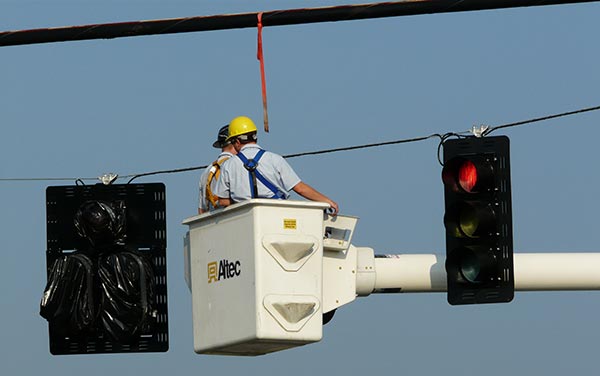
Course Description
Day 1 (MUTCD and Signalized Intersections)
A brief introduction to the history of traffic signals will illustrate the evolution of intersection traffic control through the years. The process of justifying the installation of a traffic signal will be discussed, exemplified and supported by a thorough explanation of the current MUTCD Warrants. Additional information on Part 4 of the MUTCD will be presented, focusing on the design and positioning of signal indications and illustrated with examples and tables. New MUTCD provisions, such as the optional use of "flashing yellow arrow" for permissive only or protected-permissive modes will be discussed. Guidance to design of pedestrian control features will also be provided. A description of commonly used terms in the traffic signal industry will include the definition of phase, a detailed explanation of the standard NEMA ring-and-barrier diagrams, the treatment of left-turn phases being followed by a presentation on operational characteristics of traffic signals.
Day 2 (Signal Timing)
A discussion on traffic signal timing objectives, benefits and characteristics will lead to the presentation of basic traffic flow principles and traffic signal timing strategies. Isolated signal timing, covering pre-timed and actuated operation will be followed by relevant information on coordinated signal timing. A step-by-step signal timing example will provide the opportunity to explore guidelines on the calculation of signal timing parameters for different modes of operation under different scenarios, covering cycle length, change and clearance intervals, vehicular and pedestrian intervals, etc. An overview of analysis procedures and signal timing tools will briefly instruct on how to evaluate signalized intersection performance.
Day 3 (Detection and Advanced Operations)
Simulation examples will illustrate the functionality of several controller parameters related to current guidelines on detection system design. The concepts of dilemma and indecision zone will be discussed and, low-speed and high-speed detection designs will be covered. A detailed presentation will provide appropriate values used by agencies on Volume Density settings and information on advanced controller features as well as on video detection will be presented. Relevant guidelines and references on Traffic Signal Priority Control, Traffic Responsive Control, Adaptive Traffic Signal Control and the System Engineering Analysis will be covered. Diamond Interchange Operations will be discussed and controller settings included. Preemption concepts will also be covered.
Day 4 (Traffic Signal Installation and Maintenance)
Students will become familiar with components of a traffic signal system and with appropriate traffic signal maintenance procedures. The Center for Transportation Research Traffic Signal Laboratory is a unique learning environment that allows the user to be exposed to the complexities involved with setting up and maintaining traffic signal controllers, conflict monitors, load switches, detection and communication systems on both NEMA TS-1 and TS-2 cabinets. Installation and maintenance guidelines of traffic signal supports and indications will also be provided. General information on the design and interpretation of traffic signal plans and a checklist for preventive and responsive maintenance will also be discussed. Appropriate information regarding liability and negligence will be presented in addition to guidelines to reduce exposure to lawsuits.
Day 5 (Traffic Signal Controller Programming)
Students will experiment with controller parameters on a realistic simulation environment and will be presented with information on how to navigate traffic signal controller menus, including programming instructions and interactive examples on timing parameters, detection, coordination and advanced functions.
Day 6 (Traffic Signal Systems in Oversaturated Conditions)
Agencies are frequently challenged with moving traffic in congested conditions and situations where the traffic demand exceeds the capacity of the system. The focus of this workshop is to diagnose types and causes of oversaturated conditions at signalized intersections, identify appropriate operational objectives based on observed conditions and discuss available mitigating strategies that can have an appreciable effect on overall system performance.
Contact Traffic Signal Academy
865.974.0298 • 1.800.252.7623
FAX 865.974.3889
309 Conference Center Building
Knoxville, Tennessee 37996-4133
